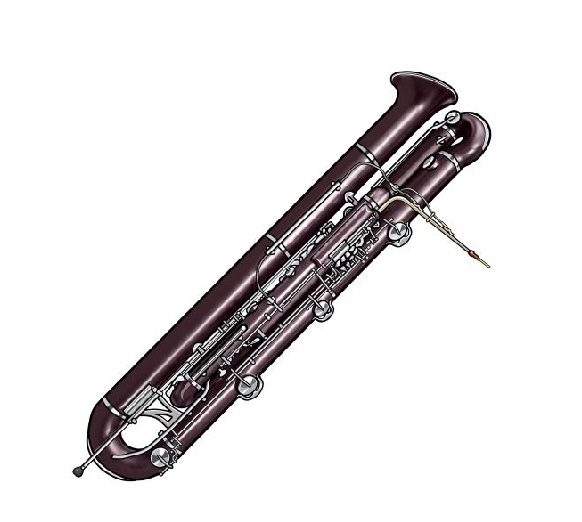Contraforte
Woodwinds
Europe
Between 1901 and present
Video
The Contraforte is a modern woodwind instrument belonging to the bassoon family. It is a contrabass instrument, designed to serve as an alternative to the contrabassoon, with significant improvements in tonal quality, projection, and playability.
Developed through a collaboration between Benedikt Eppelsheim, a German instrument maker known for his innovative designs, and Guntram Wolf, a bassoon maker, the Contraforte represents a blend of traditional craftsmanship and modern engineering. It offers a broader dynamic range, enhanced tonal clarity, and improved ergonomics for the performer.
History and Origin
Year and Place of Origin: The Contraforte was developed in Germany in the early 21st century as a response to the limitations of the contrabassoon. Its creation marked a significant evolution in contrabass woodwind design.
Benedikt Eppelsheim and Guntram Wolf sought to create an instrument that would address the technical and tonal shortcomings of the contrabassoon. This included better tuning stability, more consistent tone production, and a design that would be more player-friendly. Since its creation, the Contraforte has gained attention in both orchestral and chamber music settings. It has been used in contemporary compositions and is favored for its ability to project more effectively in large ensembles.
Purpose and Uses
The Contraforte is primarily used in symphony orchestras as a contrabass instrument to provide depth to the woodwind and string sections. Its improved projection makes it particularly valuable in large orchestral works. Many modern composers have embraced the Contraforte for its unique sound and extended range. Its dynamic flexibility makes it suitable for both solo and ensemble performances in contemporary repertoire. Due to its refined tone, the Contraforte is increasingly used in chamber music ensembles, offering a more versatile alternative to the contrabassoon. While less common than orchestral use, the Contraforte’s rich sound and expressive capabilities have made it a candidate for solo performances and experimental music.
Working Mechanism
- Double Reed: Like the bassoon and contrabassoon, the Contraforte uses a double reed to produce sound. However, the reed and mouthpiece are designed to enhance the instrument’s tonal richness and ease of playing.
- Bore Design: The Contraforte features an innovative bore design that eliminates the nasality typically associated with the contrabassoon. The bore is carefully crafted to produce a more open, rounded sound.
- Key Mechanism: The instrument’s keywork is ergonomic and modern, designed to provide greater comfort and control for the player. The improved key layout reduces strain and allows for quicker, more accurate finger movements.
- Range and Dynamics: The Contraforte has a range similar to the contrabassoon, extending down to B♭0 (or lower, depending on the model). Its dynamic range is broader, allowing for nuanced expression from pianissimo to fortissimo.
Characteristics and Key Features
The Contraforte produces a rich, rounded, and resonant tone, avoiding the nasal quality often associated with the contrabassoon. Its sound is particularly appreciated in large ensembles where clarity and projection are critical. The instrument is typically made from maple wood, with metal keywork that is robust and ergonomically designed. Special attention has been given to the key mechanism, making the instrument more accessible and comfortable for players of various hand sizes. One of the Contraforte’s standout features is its ability to project effectively in large concert halls, making it ideal for orchestral use. Its improved bore and reed design allow for a wider dynamic range, from subtle, soft tones to powerful, commanding sounds. The Contraforte incorporates advanced engineering to address tuning stability and ease of maintenance.
Significance
Innovation in Woodwind Design: The Contraforte represents a significant leap in woodwind instrument design, offering a modern solution to the limitations of traditional contrabassoons.
Enhanced Musicality: Its rich tone and broader dynamic range have opened new possibilities for composers and performers, allowing for more expressive and nuanced performances.
Versatility: The Contraforte’s ability to blend seamlessly in orchestras and chamber ensembles, while also standing out in solo performances, makes it a versatile addition to the woodwind family.
Cultural Impact: By addressing the technical challenges of the contrabassoon, the Contraforte has encouraged renewed interest in low woodwinds among composers, performers, and audiences alike.
Advocacy for Contemporary Music: The instrument has inspired new works from composers who appreciate its unique sound and technical capabilities, further enriching the repertoire for contrabass woodwinds.
The Contraforte is a remarkable modern innovation in the world of woodwind instruments. With its rich, resonant tone, enhanced playability, and versatility, it offers a compelling alternative to the traditional contrabassoon. As both a practical and expressive instrument, the Contraforte has gained a respected place in contemporary music, orchestral settings, and beyond, making it a significant addition to the woodwind family. Its continued use and development promise to expand the possibilities for low woodwinds in the 21st century and beyond.
FAQ
Who are the key manufacturers of the contraforte?
The contraforte, a modern reimagining of the contrabassoon, is primarily manufactured by Benedikt Eppelsheim in collaboration with Guntram Wolf, two renowned German instrument makers. Eppelsheim, known for innovative woodwind designs, developed the contraforte to address the tonal and ergonomic limitations of traditional contrabassoons.
What makes the contraforte different from the contrabassoon?
The contraforte differs from the contrabassoon in its design, tone, and playability. Unlike the contrabassoon, the contraforte features a redesigned bore and key system, allowing for a richer, more resonant tone with enhanced clarity and projection. Its advanced acoustics minimize the contrabassoon's characteristic "growl," creating a smoother, more refined sound.
What are the main musical applications of the contraforte?
The contraforte is primarily used in orchestral and chamber music settings, where its rich, resonant tone provides depth to the bass register. It is often employed as an alternative to the contrabassoon, offering a smoother and more refined sound in symphonic works. The contraforte is also used in modern compositions, where its extended range and tonal versatility allow for innovative musical expressions.
 Links
Links
References
Other Instrument
Categories


















